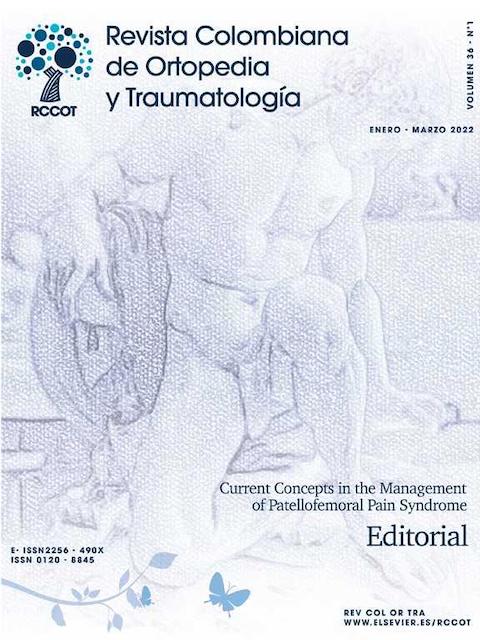Conceptos Actuales en el Manejo del Síndrome de Dolor Patelofemoral
DOI:
https://doi.org/10.1016/j.rccot.2022.04.008Palabras clave:
síndrome de dolor patelofemoral, terapia física, ortesis de pie, artroscopiaResumen
Introducción: El síndrome de dolor patelofemoral (SDPF) es una de las principales causas de dolor de rodilla y se presenta con actividades diarias de la vida cotidiana. Este estudio presenta una revisión de la literatura acerca de las modalidades de tratamiento actual para el SDPF.
Materiales y métodos: Revisión estado del arte acerca del tratamiento del SDPF con grados de recomendación según la evidencia. Se revisan las intervenciones conservadoras activas y pasivas, así mismo las alternativas quirúrgicas.
Resultados: El fortalecimiento de los músculos de la cadera y del miembro inferior, así como el estiramiento, son intervenciones activas que ofrecen beneficios en el largo plazo para el SDPF. Las intervenciones pasivas como las rodilleras, el kinesiotaping y las ortesis para los pies, ofrecen alivio rápido pero de corta duración. El tratamiento quirúrgico solamente se recomienda en un subgrupo de pacientes que no han respondido a otros tratamientos y que tienen ciertas anormalidades anatómicas específicas que alteran la articulación patelofemoral.
Discusión: El tratamiento conservador continúa siendo la piedra angular en el tratamiento del síndrome de dolor patelofemoral,
Nivel de evidencia: IV, Revisión Clínica.
Descargas
Referencias bibliográficas
Crossley KM, Stefanik JJ, Selfe J, Collins NJ, Davis IS, Powers CM, et al. 2016 Patellofemoral pain consensus statement from the 4th International Patellofemoral Pain Research Retreat Manchester. Part 1: Terminology, definitions, clinical examination, natural history, patellofemoral osteoarthritis and patient-reported outcome m. Br J Sports Med. 2016;50:839-43, http://dx.doi.org/10.1136/bjsports-2016-096384.
Boling M, Padua D, Marshall S, Guskiewicz K, Pyne S, Beutler A. Gender differences in the incidence and prevalence of patellofemoral pain syndrome. Scand J Med Sci Sport. 2010;20:725-30, http://dx.doi.org/10.1111/j.1600-0838.2009.00996.x.
Petersen W, Ellermann A, Gosele-Koppenburg A, Best R, Rembitzki IV, Bruggemann GP, et al. Patellofemoral pain syndrome. Knee Surg Sport Traumatol Arthrosc. 2014;22:2264-74, http://dx.doi.org/10.1007/s00167-013-2759-6.
Dehaven KE, Lintner DM. Athletic injuries: Comparison by age, sport, and gender. Am J Sports Med. 1986;14:218-24, http://dx.doi.org/10.1177/036354658601400307.
Devereaux MD, Lachmann SM. Patello-femoral arthralgia in athletes attending a Sports Injury Clinic. Br J Sports Med. 1984;18:18-21, http://dx.doi.org/10.1136/bjsm.18.1.18.
Pappas E, Wong-Tom WM. Prospective Predictors of Patellofemoral Pain Syndrome: A Systematic Review With Meta-analysis. Sports Health. 2012;4:115-20, http://dx.doi.org/10.1177/1941738111432097.
Witvrouw E, Lysens R, Bellemans J, Cambier D, Vanderstraeten G. Intrinsic risk factors for the development of anterior knee pain in an athletic population: A twoyear prospective study. Am J Sports Med. 2000;28:480-9, http://dx.doi.org/10.1177/03635465000280040701.
Dutton RA, Khadavi MJ, Fredericson M. Patellofemoral Pain. Phys Med Rehabil Clin N Am. 2016;27:31-52, http://dx.doi.org/10.1016/j.pmr.2015.08.002.
Barton CJ, Lack S, Hemmings S, Tufail S, Morrissey D. The ‘‘Best Practice Guide to Conservative Management of Patellofemoral Pain’’: incorporating level 1 evidence with expert clinical reasoning. Br J Sports Med. 2015;49:923-34, http://dx.doi.org/10.1136/bjsports-2014-093637.
Kettunen JA, Harilainen A, Sandelin J, Schlenzka D, Hietaniemi K, Seitsalo S, et al. Knee arthroscopy and exercise versus exercise only for chronic patellofemoral pain syndrome: a randomized controlled trial. BMC Med. 2007;5:38, http://dx.doi.org/10.1186/1741-7015-5-38.
Kettunen JA, Harilainen A, Sandelin J, Schlenzka D, Hietaniemi K, Seitsalo S, et al. Knee arthroscopy and exercise versus exercise only for chronic patellofemoral pain syndrome: 5-year follow-up. Br J Sports Med. 2012;46:243-6, http://dx.doi.org/10.1136/bjsm.2010.079020.
Collins NJ, Bisset LM, Crossley KM, Vicenzino B. Efficacy of nonsurgical interventions for anterior knee pain: Systematic review and meta-analysis of randomized trials. Sport Med. 2012;42:31-49, http://dx.doi.org/10.2165/11594460-000000000-00000.
Crossley KM, Bennell KL, Cowan SM, Green S. Analysis of outcome measures for persons with patellofemoral pain: which are reliable and valid? Arch Phys Med Rehabil. 2004;85:815-22, http://dx.doi.org/10.1016/s0003-9993(03)00613-0.
Pfeiffer RP, DeBeliso M, Shea KG, Kelley L, Irmischer B, Harris C. Kinematic MRI Assessment of McConnell Taping before and after Exercise. Am J Sports Med. 2004;32:621-8, http://dx.doi.org/10.1177/0363546503261693.
Warden SJ, Hinman RS, Watson MA, Avin KG, Bialocerkowski AE, Crossley KM. Patellar taping and bracing for the treatment of chronic knee pain: A systematic review and meta-analysis. Arthritis Care Res. 2008;59:73-83, http://dx.doi.org/10.1002/art.23242.
Barton CJ, Levinger P, Menz HB, Webster KE. Kinematic gait characteristics associated with patellofemoral pain syndrome: A systematic review. Gait Posture. 2009;30:405-16, http://dx.doi.org/10.1016/j.gaitpost.2009.07.109.
Collins NJ, Bisset LM, Crossley KM, Vicenzino B. Efficacy of Nonsurgical Interventions for Anterior Knee Pain. Sport Med. 2012;42:31-49, http://dx.doi.org/10.2165/11594460-000000000-00000.
Heintjes EM, Berger M, Bierma-Zeinstra SM, Bernsen RM, Verhaar JA, Koes BW. Pharmacotherapy for patellofemoral pain syndrome. Cochrane Database Syst Rev. 2004:CD003470, http://dx.doi.org/10.1002/14651858.cd003470.pub2.
Eapen C, Nayak CD, Zulfeequer CP. Effect of eccentric isotonic quadriceps muscle exercises on patellofemoral pain syndrome: An exploratory pilot study. Asian J Sports Med. 2011;2:227-34, http://dx.doi.org/10.5812/asjsm.34747.
Chiu JKW, Wong YM, Yung PSH, Ng GYF. The effects of quadriceps strengthening on pain, function, and patellofemoral joint contact area in persons with patellofemoral pain. Am J Phys Med Rehabil. 2012;91:98-106, http://dx.doi.org/10.1097/PHM.0b013e318228c505.
Khayambashi K, Mohammadkhani Z, Ghaznavi K, Lyle MA, Powers CM. The effects of isolated hip abductor and external rotator muscle strengthening on pain, health status, and hip strength in females with patellofemoral pain: A randomized controlled trial. J Orthop Sports Phys Ther. 2012;42:22-9, http://dx.doi.org/10.2519/jospt.2012.3704.
Fukuda TY, Melo WP, Zaffalon BM, Rossetto FM, Magalhaes E, Bryk FF, et al. Hip posterolateral musculature strengthening in sedentary women with patellofemoral pain syndrome: A randomized controlled clinical trial with 1- year follow-up. J Orthop Sports Phys Ther. 2012;42:823-30, http://dx.doi.org/10.2519/jospt.2012.4184.
Dolak KL, Silkman C, Mckeon JM, Hosey RG, Lattermann C, Uhl TL. Hip strengthening prior to functional exercises reduces pain sooner than quadriceps strengthening in females with patellofemoral pain syndrome: A randomized clinical trial. J Orthop Sports Phys Ther. 2011;41:560-70, http://dx.doi.org/10.2519/jospt.2011.3499.
Ferber R, Bolgla L, Earl-Boehm JE, Emery C, Hamstra-Wright K. Strengthening of the hip and core versus knee muscles for the treatment of patellofemoral pain: A multicenter randomized controlled trial. J Athl Train. 2015;50:366-77, http://dx.doi.org/10.4085/1062-6050-49.3.70.
Khayambashi K, Fallah A, Movahedi A, Bagwell J, Powers C. Posterolateral hip muscle strengthening versus quadriceps strengthening for patellofemoral pain: A comparative control trial. Arch Phys Med Rehabil. 2014;95:900-7, http://dx.doi.org/10.1016/j.apmr.2013.12.022.
De Marche Baldon R, Serrão FV, Silva RS, Piva SR. Effects of functional stabilization training on pain, function, and lower extremity biomechanics in women with patellofemoral pain: A randomized clinical trial. J Orthop Sports Phys Ther. 2014;44:240-51, http://dx.doi.org/10.2519/jospt.2014.4940.
Earl-Boehm JE, Bolgla LA, Emory C, Hamstra-Wright KL, Tarima S, Ferber R. Treatment success of hip and core or knee strengthening for patellofemoral pain: Development of clinical prediction rules. J Athl Train. 2018;53:545-52, http://dx.doi.org/10.4085/1062-6050-510-16.
Saad MC, Vasconcelos RA, de, Mancinelli LV, de O, Munno MS, de B, Liporaci RF, Grossi DB. Is hip strengthening the best treatment option for females with patellofemoral pain? A randomized controlled trial of three different types of exercises. Brazilian J Phys Ther. 2018;22:408-16, http://dx.doi.org/10.1016/j.bjpt.2018.03.009.
Peeler J, Anderson JE. Effectiveness of static quadriceps stretching in individuals with patellofemoral joint pain. Clin J Sport Med. 2007;17:234-41, http://dx.doi.org/10.1097/JSM.0b013e3180f60afc.
Avraham F, Aviv S, Ya’akobi P, Faran H, Fisher Z, Goldman Y, et al. The efficacy of treatment of different intervention programs for patellofemoral pain syndrome - A single blinded randomized clinical trial. Pilot study. ScientificWorldJournal. 2007;7:1256-62, http://dx.doi.org/10.1100/tsw.2007.167.
Lee JH, Jang KM, Kim E, Rhim HC, Kim HD. Effects of Static and Dynamic Stretching With Strengthening Exercises in Patients With Patellofemoral Pain Who Have Inflexible Hamstrings: A Randomized Controlled Trial. Sports Health. 2021;13:49-56, http://dx.doi.org/10.1177/1941738120932911.
Mason M, Keays SL, Newcombe PA. The Effect of Taping Quadriceps Strengthening and Stretching Prescribed Separately or Combined on Patellofemoral Pain. Physiother Res Int. 2011;16:109-19, http://dx.doi.org/10.1002/pri.486.
Moyano FR, Valenza MC, Martin LM, Caballero YC, Gonzalez-Jimenez E, Demet GV. Effectiveness of different exercises and stretching physiotherapy on pain and movement in patellofemoral pain syndrome: A randomized controlled trial. Clin Rehabil. 2013;27:409-17, http://dx.doi.org/10.1177/0269215512459277.
Osorio JA, Vairo GL, Rozea GD, Bosha PJ, Millard RL, Auckerman DF, et al. The effects of two therapeutic patellofemoral taping techniques on strength, endurance, and pain responses. Phys Ther Sport. 2013;14:199-206, http://dx.doi.org/10.1016/j.ptsp.2012.09.006.
Kuru T, Yaliman A, Dereli EE. Comparison of efficiency of Kinesio® taping and electrical stimulation in patients with patellofemoral pain syndrome. Acta Orthop Traumatol Turc. 2012;46:385-92, http://dx.doi.org/10.3944/AOTT. 2012.2682.
Demirci S, Kinikli GI, Callaghan MJ, Tunay VB. Comparison of short-term effects of mobilization with movement and Kinesiotaping on pain, function and balance in patellofemoral pain. Acta Orthop Traumatol Turc. 2017;51:442-7, http://dx.doi.org/10.1016/j.aott.2017.09.005.
Akbas¸ E, Atay AÖ, Yüksel I. The effects of additional kinesio taping over exercise in the treatment of patellofemoral pain syndrome. Acta Orthop Traumatol Turc. 2011;45:335-41, http://dx.doi.org/10.3944/AOTT.2011.2403.
Ghourbanpour A, Talebi GA, Hosseinzadeh S, Janmohammadi N, Taghipour M. Effects of patellar taping on knee pain, functional disability, and patellar alignments in patients with patellofemoral pain syndrome: A randomized clinical trial. J Bodyw Mov Ther. 2018;22:493-7, http://dx.doi.org/10.1016/j.jbmt.2017.06.005.
Collins N, Crossley K, Beller E, Darnell R, McPoil T, Vicenzino B. Foot orthoses and physiotherapy in the treatment of patellofemoral pain syndrome: Randomised clinical trial. Bmj. 2008;337:1034-6, http://dx.doi.org/10.1136/bmj.a1735.
Mølgaard CM, Rathleff MS, Andreasen J, Christensen M, Lundbye- Christensen S, Simonsen O, et al. Foot exercises and foot orthoses are more effective than knee focused exercises in individuals with patellofemoral pain. J Sci Med Sport. 2018;21:10-5, http://dx.doi.org/10.1016/j.jsams.2017.05.019.
Vicenzino B, Collins N, Cleland J, McPoil T. A clinical prediction rule for identifying patients with patellofemoral pain who are likely to benefit from foot orthoses: A preliminary determination. Br J Sports Med. 2010;44:862-6, http://dx.doi.org/10.1136/bjsm.2008.052613.
Lun VMY, Wiley JP, Meeuwisse WH, Yanagawa TL. Effectiveness of patellar bracing for treatment of patellofemoral pain syndrome. Clin J Sport Med. 2005;15:235-40, http://dx.doi.org/10.1097/01.jsm.0000171258.16941.13.
Petersen W, Ellermann A, Rembitzki IV, Scheffler S, Herbort M, Brüggemann GP, et al. Evaluating the potential synergistic benefit of a realignment brace on patients receiving exercise therapy for patellofemoral pain syndrome: a randomized clinical trial. Arch Orthop Trauma Surg. 2016;136:975-82, http://dx.doi.org/10.1007/s00402-016-2464-2.
Sanchis-Alfonso V, Ramírez-Fuentes C, Ferràs-Tarragó J, Teitge RA. Is There a Surgical Treatment of Patellofemoral Pain? In: Patellofemoral Pain. Instability, and Arthritis.;. 2020, http://dx.doi.org/10.1007/978-3-662-61097-811.
Dannawi Z, Khanduja V, Palmer CR, El-Zebdeh M. Evaluation of the modified Elmslie-Trillat procedure for patellofemoral dysfunction. Orthopedics. 2010;33:13, http://dx.doi.org/10.3928/01477447-20091124-07.
Tigchelaar S, Van Essen P, Bénard M, Koëter S, Wymenga A. A self-centring osteotomy of the tibial tubercle for patellar maltracking or instability: Results with ten-years’ follow-up. Bone Jt J. 2015;97-B:36-29, http://dx.doi.org/10.1302/0301-620X.97B3.34515.
Pagenstert G, Wolf N, Bachmann M, Gravius S, Barg A, Hintermann B, et al. Open lateral patellar retinacular lengthening versus open retinacular release in lateral patellar hypercompression syndrome: A prospective double-blinded comparative study on complications and outcome. Arthrosc - J Arthrosc Relat Surg. 2012;28:788-97, http://dx.doi.org/10.1016/j.arthro.2011.11.004.
Imhoff FB, Cotic M, Liska F, Dyrna FGE, Beitzel K, Imhoff AB, et al. Derotational osteotomy at the distal femur is effective to treat patients with patellar instability. Knee Surgery, Sport Traumatol Arthrosc. 2019;27:652-8, http://dx.doi.org/10.1007/s00167-018-5212-z.
Stevens PM, Gililland JM, Anderson LA, Mickelson JB, Nielson J, Klatt JW. Success of torsional correction surgery after failed surgeries for patellofemoral pain and instability. Strateg Trauma Limb Reconstr. 2014;9:5-12, http://dx.doi.org/10.1007/s11751-013-0181-8.
Manilov R, Chahla J, Maldonado S, Altintas B, Manilov M, Zampogna B. High tibial derotation osteotomy for distal extensor mechanism alignment in patients with squinting patella due to increased external tibial torsion. Knee. 2020;27:1931-41, http://dx.doi.org/10.1016/j.knee.2020.10.006.









